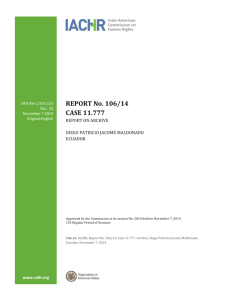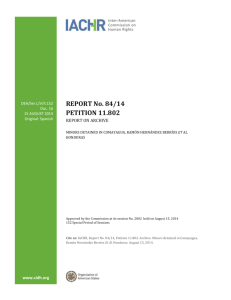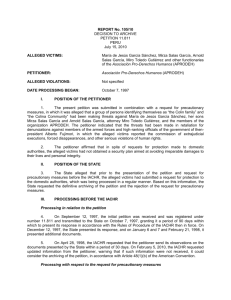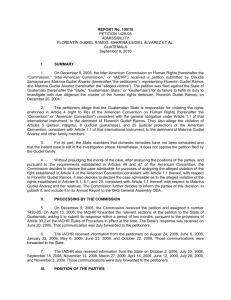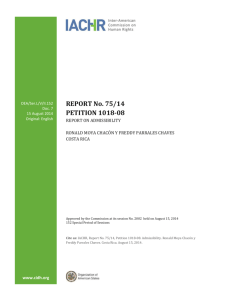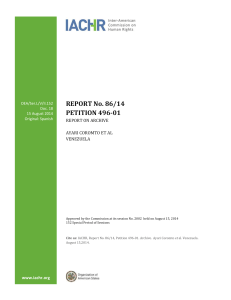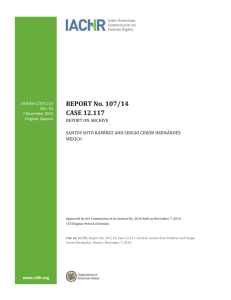Admissibility Report No. 87/12 - Organization of American States
advertisement
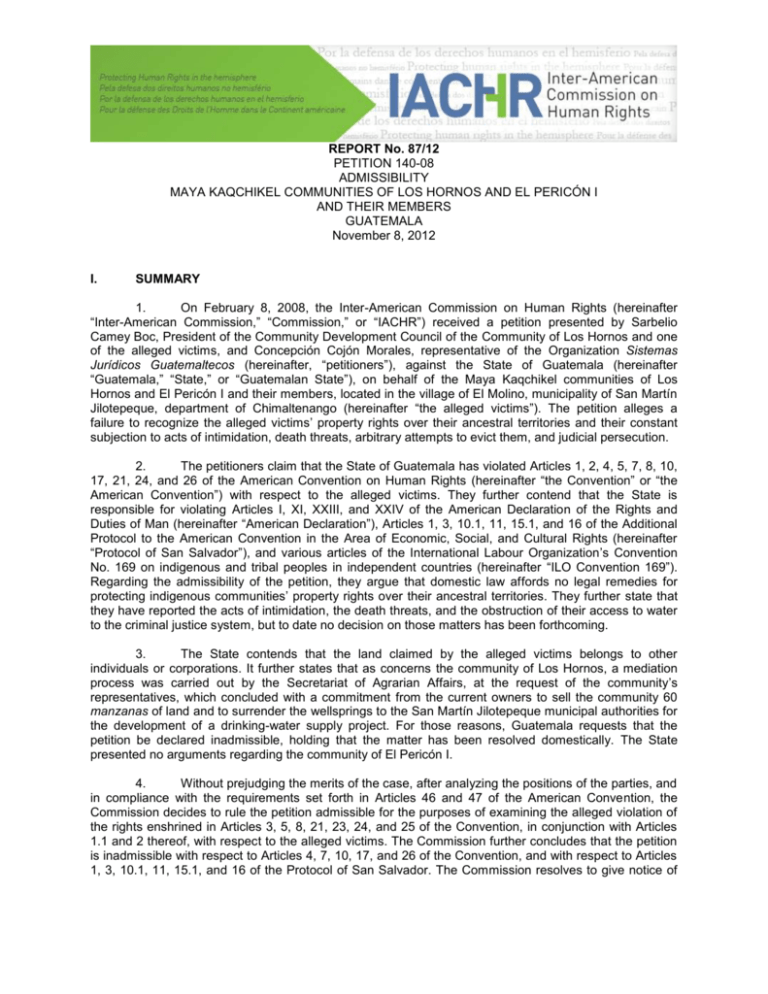
REPORT No. 87/12 PETITION 140-08 ADMISSIBILITY MAYA KAQCHIKEL COMMUNITIES OF LOS HORNOS AND EL PERICÓN I AND THEIR MEMBERS GUATEMALA November 8, 2012 I. SUMMARY 1. On February 8, 2008, the Inter-American Commission on Human Rights (hereinafter “Inter-American Commission,” “Commission,” or “IACHR”) received a petition presented by Sarbelio Camey Boc, President of the Community Development Council of the Community of Los Hornos and one of the alleged victims, and Concepción Cojón Morales, representative of the Organization Sistemas Jurídicos Guatemaltecos (hereinafter, “petitioners”), against the State of Guatemala (hereinafter “Guatemala,” “State,” or “Guatemalan State”), on behalf of the Maya Kaqchikel communities of Los Hornos and El Pericón I and their members, located in the village of El Molino, municipality of San Martín Jilotepeque, department of Chimaltenango (hereinafter “the alleged victims”). The petition alleges a failure to recognize the alleged victims’ property rights over their ancestral territories and their constant subjection to acts of intimidation, death threats, arbitrary attempts to evict them, and judicial persecution. 2. The petitioners claim that the State of Guatemala has violated Articles 1, 2, 4, 5, 7, 8, 10, 17, 21, 24, and 26 of the American Convention on Human Rights (hereinafter “the Convention” or “the American Convention”) with respect to the alleged victims. They further contend that the State is responsible for violating Articles I, XI, XXIII, and XXIV of the American Declaration of the Rights and Duties of Man (hereinafter “American Declaration”), Articles 1, 3, 10.1, 11, 15.1, and 16 of the Additional Protocol to the American Convention in the Area of Economic, Social, and Cultural Rights (hereinafter “Protocol of San Salvador”), and various articles of the International Labour Organization’s Convention No. 169 on indigenous and tribal peoples in independent countries (hereinafter “ILO Convention 169”). Regarding the admissibility of the petition, they argue that domestic law affords no legal remedies for protecting indigenous communities’ property rights over their ancestral territories. They further state that they have reported the acts of intimidation, the death threats, and the obstruction of their access to water to the criminal justice system, but to date no decision on those matters has been forthcoming. 3. The State contends that the land claimed by the alleged victims belongs to other individuals or corporations. It further states that as concerns the community of Los Hornos, a mediation process was carried out by the Secretariat of Agrarian Affairs, at the request of the community’s representatives, which concluded with a commitment from the current owners to sell the community 60 manzanas of land and to surrender the wellsprings to the San Martín Jilotepeque municipal authorities for the development of a drinking-water supply project. For those reasons, Guatemala requests that the petition be declared inadmissible, holding that the matter has been resolved domestically. The State presented no arguments regarding the community of El Pericón I. 4. Without prejudging the merits of the case, after analyzing the positions of the parties, and in compliance with the requirements set forth in Articles 46 and 47 of the American Convention, the Commission decides to rule the petition admissible for the purposes of examining the alleged violation of the rights enshrined in Articles 3, 5, 8, 21, 23, 24, and 25 of the Convention, in conjunction with Articles 1.1 and 2 thereof, with respect to the alleged victims. The Commission further concludes that the petition is inadmissible with respect to Articles 4, 7, 10, 17, and 26 of the Convention, and with respect to Articles 1, 3, 10.1, 11, 15.1, and 16 of the Protocol of San Salvador. The Commission resolves to give notice of 2 this decision to the parties, and to publish it and include it in its Annual Report to the General Assembly of the Organization of American States. II. PROCEEDINGS BEFORE THE COMMISSION 5. On February 8, 2008, the Commission received the petition and recorded it as No. 14008. On August 20, 2010, it forwarded the petition’s relevant parts to the State, along with a request for it to return its reply within a period of two months, in compliance with the provisions of Article 30.3 of the Rules of Procedure. The State’s reply was received on October 26, 2010, and was duly forwarded to the petitioners. 6. The IACHR also received additional information from the petitioners in communications of August 29, 2008, June 10, 2009, March 8, 2011, December 7, 2011, and February 6, 2012. Those communications were duly forwarded to the State. The IACHR received further comments from the State on August 29, 2011, which was duly conveyed to the petitioners. 7. On the same date that the petition was lodged, the petitioners requested the adoption of precautionary measures in order to ensure free access and use of the wellsprings located at Joya Larga, belonging to the estate known as the “Finca El Retiro del Quisayá”. That application was repeated in a letter received on March 8, 2011, which was forwarded to the State along with a request for information on the situation, in compliance with Article 25.5 of the IACHR’s Rules of Procedure. The State’s reply was received on June 17, 2011, and was duly forwarded to the petitioners.1 The Commission continues to monitor the situation. III. POSITIONS OF THE PARTIES A. Position of the Petitioners 8. The petitioners contend that the indigenous communities of Los Hornos and Pericón I, belonging to the Maya Kaqchikel indigenous people, have occupied, since time immemorial, the territory known as “Pueblo Antiguo Pasalac” – or, in the Kaqchikel language, “Ojer Tinamit” – which covers an area of 16.5 caballerías and is located in the village of El Molino, municipality of San Martín Jilotepeque, department of Chimaltenango. They claim there are numerous indications of their ancestral occupation of that land, including archaeological remains and the oral tradition of the communities’ elders. Notwithstanding that, the State has repeatedly awarded ownership of the land to private citizens, in denial of the communities’ rights. 9. They report that during colonial times, the lands were usurped. They were placed under the encomienda regime and handed over, along with its inhabitants, to priests of the Mercedarian order. They report that in 1871, the lands returned to the control of the State and were later sold off to a private citizen, in a transaction that again included the communities that inhabited them. Thereupon, they contend, the lands were renamed “Finca la Merced” and were recorded in the General Property Register in 1903. They state that the Maya Kaqchikel communities remained on the lands, subject to the owners’ will, to provide labor in exchange for derisory payments made in kind. 10. They indicate that, in order to protect the estate from the Agrarian Reform Law (Decree 900), its owner signed an agreement with the State on December 14, 1955, agreeing to separate from it an area of eight caballerías. According to the petitioners, that area of land was subdivided into 132 plots, of which 125 were awarded to that number of campesinos, with the remaining seven going to the Agrarian Affairs Directorate. 1 The IACHR also received information from the petitioners on October 3, 2011, and on February 6, 2012. In turn, the State presented the IACHR with information on September 14, 2011, and June 6, 2012. 3 11. They state that “Finca la Merced” was later subdivided and recorded in the General Property Register as belonging to three private companies: “Lotificadora Esperanza,” “Finca el Retiro del Quisayá,” and “Tupilaj.” They inform that “Lotificadora Esperanza” sold part of its holding to neighboring campesino communities, and “Finca el Retiro del Quisayá” sold part of its holding to another private company, called “Grupo de Marcial.” 12. According to information furnished by the petitioners, the community of Los Hornos is currently located on an area of five caballerías – the equivalent of 300 manzanas registered as belonging to “Lotificadora Esperanza”, and the community of Pericón I is located on 37 manzanas sold by “Lotificadora Esperanza” to campesinos from neighboring communities. They note that the communities are organized in accordance with the principles, values, rules, and procedures inherent to the political and social structure of the Maya Kaqchikel people. Thus, they have established in Community Development Councils (COCODEs) and community assemblies made up of their inhabitants. The petitioners report that they have no legal recognition as indigenous communities. 13. They claim that the alleged victims’ situation has worsened since December 2007, when they were denied access to water from the only spring found on their territory, located on the “Finca El Retiro del Quisayá” estate. They report that using barbed-wire and wooden posts, the owners have fenced off the area where 28 wells used by the community are located, and that they have sowed “a very poisonous and deadly kind of weed” to hinder access along the path used to fetch water. The petitioners state that the estates’ security guards intimidate the alleged victims, through such actions as firing their weapons when the community members try to obtain water, enter the forest, or lead their animals to certain areas of pasture. They note that the women are most severely affected, because they are responsible for the tasks of fetching water and washing clothes in the river. 14. Within this context of intimidation, say the petitioners, the alleged victims have faced judicial persecution at the hands of the estate owners. Specifically, they refer to the criminal proceeding C-467-05-OF.1, brought before the Justice of the Peace of San Martín Jilotepeque municipality against Sarbelio Camey Boc, President of the Los Hornos COCODE, for felling two trees on “Finca El Retiro del Quisayá”, a part of the territory claimed by the indigenous communities. They report that Sarbelio Camey Boc was found guilty of a crime against forestry resources and ordered to pay a fine. 15. The petitioners also report that in April 2002, a criminal complaint was filed against eleven members of the indigenous communities for the crimes of coercion, threats, property invasions with specific aggravating circumstances, and illegal demonstrations, for incidents related to a public demonstration in front of the estate-owner’s house. According to the information furnished, some of the accused were convicted, and the office of the Ombudsman for Human Rights intervened “to have the cases removed from the judicial system.” 16. In addition, the petitioners contend that community members have been criminally prosecuted on many occasions for the crime of misappropriation. Specifically, they cite the following cases: MP043-2002-907; MP043-2007-4017; MP043-2003-533; and MP043-2003-553, prosecutorial investigation that culminated with criminal proceedings No. C-105-2003-OF.1, before the Justice of the Peace of San Martín Jilotepeque municipality. They claim that in several of those cases, they did not have the assistance of legal counsel. They further state that they have no additional information regarding the current status of those proceedings and investigations, because in spite of repeated requests for information, they have received no response from the competent authorities. 17. They add that the alleged victims face constant threats of eviction. They report that the estate owners, accompanied by officers of the National Civilian Police, have tried to evict them, absent an order from a competent judge. As a result of these frequent acts of intimidation and the threat of being stripped of their own land, the alleged victims were forced to ask the current owners to begin negotiations to buy back their ancestral territories. 18. They report that to make that happen, they requested the intervention of the Secretariat of Agrarian Affairs (SAA), which agreed to open talks and facilitate a dialogue; as a result, the SAA’s 4 Undersecretariat for Conflict Resolution embarked on separate negotiation processes for each community. The petitioners contend that this agency “has at no time resolved the conflict, nor has it addressed the matter of the indigenous people’s ancestral rights over the land”; instead, “its mission has been to negotiate the value of the land as set by the landowners.” They also report that one of the conditions imposed by the estate owners was that Sarbelio Camey Boc, President of the Los Hornos community COCODE, not participate in the negotiations, and that condition was accepted by the SAA. They claim the communities were forced to accept that condition, under pressure and the threat of being stripped of the lands they have historically occupied and that, as a consequence of his inability to participate, some community members were not represented in the mediation process. 19. According to the information provided, following that process, on June 2, 2010, the community of El Pericón I reportedly signed a purchase and intermediation contract with “Lotificadora Esperanza” in which it agreed to pay, using its own funds, the amount of Q666,000.00 (six hundred and sixty-six thousand quetzals) to buy 37 manzanas. In turn, on August 4, 2010, the community of Los Hornos signed a promissory purchase contract with “Lotificadora Esperanza” in which it agreed to pay Q1,080,000.00 (one million, eighty thousand quetzals) for an area of 60 manzanas. They claim they are currently paying those amounts on a six-monthly basis, which is very difficult because “Guatemalan farm workers earn around US$3.00 per day.” 20. With respect to water access, they report that the latter contract provided that “the area of the wellspring will be measured and the water will be delivered to the municipality of San Martín Jilotepeque to ensure all its inhabitants access to the vital liquid.” However, they contend that this water source is insufficient to supply the communities and that the spring they traditionally used is located at Joya Larga, in an area that “Finca El Retiro del Quisayá” sold to “Grupo de Marcial”. They further report that the new owners are digging a trench of some three meters in width and two and a half meters in depth, “in order to dredge the springs and drain the swamp where they rise.” 21. Regarding the exhaustion of domestic remedies, they maintain that Guatemalan domestic law affords no legal remedies for protecting indigenous communities’ property rights over their ancestral territories. In response to the State’s contentions, they report that an injunction for amparo, possession, or tenure was not filed because “it is only temporary in nature: in other words, it does not cause res judicata, given than the civil and commercial procedural law of the Republic of Guatemala clearly states that such proceedings do not examine the ownership of the property.” 22. In addition, the petitioners state that on May 31, 2006, Sarbelio Camey Boc, José Bacilio Chonay Lopez, and José Balerio Chonay reported acts of intimidation and the denial of access to water by the estate security personnel to the National Civilian Police post in San Martín Jilotepeque. They report that an investigation, No. MP043-2006-3404, was opened, but they have not been informed of the results of the proceedings. They add that they requested a copy of the case file but that they received no reply. 23. In addition, they report that for several years, they have been pursuing numerous formalities with various state authorities.2 They contend that in spite of numerous steps that have been taken, they have received no response to their claims asserting their rights. 2 In particular, they cite: (1) Communication of June 2005, addressed to the Governor of Chimaltenango, the District Commissioner of the National Civilian Police, the Mayor of San Martín Jilotepeque Municipality, the Chief Officer of the Nature Protection Secretariat (SEPRONA) for the department of Chimaltenango, the Justice of the Peace of San Martín Jilotepeque, and the Assistant of the Office of the Ombudsman for Human Rights for Chimaltenango, reporting threats of eviction and acts of intimidation made against them; (2) Communication of August 7, 2006, addressed to the Departmental Assistant of the Human Rights Ombudsman for Chimaltenango, reporting threats of eviction from lands they have historically occupied; (3) Communication of October 12, 2006, sent to the Secretariat of Agrarian Affairs of the office of the President of the Republic, requesting its intervention in the removal of private guards preventing access to water sources; (4) Visit request addressed to the Indigenous Peoples Defense Office of the office of the Ombudsman for Human Rights, dated March 9, 2007, reporting the situation described. 5 24. Based on the foregoing, the petitioners hold that the State of Guatemala violated Articles 1, 2, 4, 5, 7, 8, 10, 17, 21, 24, and 26 of the American Convention with respect to the alleged victims. They further contend that the State is responsible for violating Articles I, XI, XXIII, and XXIV of the American Declaration, Articles 1, 3, 10.1, 11, 15.1, and 16 of the Protocol of San Salvador, and Articles 2.1, 3, 4, 5, 17.3, and 18 of ILO Convention 169. B. Position of the State 25. The State maintains that the situation described by the petitioners arose from the different agrarian policies pursued over a century ago, which can be seen in the fact that, as indicated in the books of the General Property Register, the first record of ownership of “Finca La Merced” was made in 1903. With reference to the current ownership situation, the State notes that it is recorded in three separate entries in the register, in the names of three limited corporations: Lotificadora Esperanza, Finca El Retiro del Quisayá, and Tupilaj. In Guatemala’s opinion, the petitioners acknowledge that the land they are claiming is private property and that its occupation is incompatible with the framework of the law. 26. In addition, Guatemala states that the Secretariat of Agrarian Affairs is the agency responsible for heading and coordinating activities involving “agrarian policy and for attending to, resolving, preventing, and transforming disputes and conflicts arising from land ownership and land tenure, pursuant to the Constitution of the Republic of Guatemala, the Peace Accords, the international agreements and covenants ratified by Guatemala, and the principles of freedom, equality, and solidarity.” It adds that the Presidential Office for Legal Assistance and Resolution of Land Disputes (CONTIERRA) is a part of the SAA’s administrative structure, and has become the Undersecretariat for Conflict Resolution, “which works with such alternative conflict resolution methods as mediation, negotiation, conciliation, and arbitration.” 27. Accordingly, Guatemala contends that the Undersecretariat for Conflict Resolution intervened in the situation of the community of Los Hornos, at the request of its representatives, and conducted a mediation process with the owners of the “Lotificadora Esperanza” estate. It states that the process began in February 2009, after the setting of “conditions favoring dialogue and negotiation, under the condition that Mr. Sarvelio (sic) Camey would not participate in the meetings.” It contends that the community decided he, despite being a community authority, would not be involved in the proceedings. 28. Guatemala reports that a mediation process was conducted between February 2009 and May 17, 2010, which concluded with an agreement from the estate’s owners to sell the community of Los Hornos 60 manzanas and to hand over the wellsprings to the municipality of San Martín Jilotepeque for the development of a drinking-water supply project. It states that the community’s representatives agreed to return four manzanas that were not included in the area to be sold; to respect the limits of the neighboring property, and to cause no damage; and to allow municipal workers to develop the aforesaid water-supply project. It reports that on August 10, 2010, the parties signed the promissory sales contract, thereby “concluding the intervention of the Undersecretariat for Conflict Resolution of the Secretariat of Agrarian Affairs.” It underscores the role of the SAA, noting that “it succeeded in opening the relevant channels for dialogue, ensuring that the meetings were held with due respect, and identifying solutions that were in accordance with the parties’ needs.” 29. With regard to the existing domestic remedies, Guatemala holds that “it only has a technical procedure for recognizing community-held lands for land registration purposes; but there are other ways to resolve land tenure and ownership problems, such as the mediation, negotiation, and arbitration offered by the Secretariat of Agrarian Affairs.” It thus indicates that the community of Los Hornos embarked on such administrative proceedings to resolve the matter of the petition before the IACHR, which gave rise to the signing of the contract described above. For those reasons. Guatemala requests that the petition be declared inadmissible, holding that the matter has been resolved domestically. IV. ANALYSIS OF ADMISSIBILITY 6 A. Competence of the Commission Ratione Personae, Ratione Loci, Ratione Temporis, and Ratione Materiae 30. The petitioners are entitled, under Article 44 of the American Convention, to lodge complaints with the IACHR. The petitioners indicate, as the alleged victims, the Maya Kaqchikel communities of Los Hornos and El Pericón I and their members,3 with respect to whom the State of Guatemala has agreed to respect and ensure the rights enshrined in the American Convention.4 With reference to the State, the Commission notes that Guatemala has been a state party to the American Convention since May 25, 1978, when it deposited its instrument of ratification. The Commission therefore has competence ratione personae to examine the petition. 31. Similarly, the Commission has competence ratione loci to hear the petition, since it alleges violations of rights protected by the American Convention occurring under the jurisdiction of the State. The Commission has competence ratione temporis with respect to the alleged facts in that they took place when the obligation of respecting and ensuring the rights set out in the Convention was already in force in Guatemala. Regarding the alleged violation of rights enshrined in the American Declaration, while both the Court and the Commission have ruled that the American Declaration is a source of international obligations for OAS member states, 5 the IACHR will study the alleged facts that took place prior to Guatemala’s ratification of the Convention on May 25, 1978, in light of the obligations contained in the American Declaration.6 Finally, the Commission has competence ratione materiae since the petition describes possible violations of human rights that are protected by the American Convention. 32. Regarding the alleged violation of Articles 1, 3, 10.1, 11, 15.1, and 16 of the Protocol of San Salvador, the IACHR lacks the competence to rule on breaches of those provisions in the context of an individual case, as stipulated in Article 19.6 of that Protocol. Regarding the request that the State be declared in violation of ILO Convention 169, the Commission does not have competence in this regard; however, it may use it as a guideline for interpreting Convention obligations pursuant to the terms of Article 29 of the American Convention.7 B. Other Admissibility Requirements of the Petition 1. Exhaustion of Domestic Remedies 3 In this regard, see: IACHR, Report No. 63/10, Garifuna Community of Punta Piedra and its Members (Honduras), March 24, 2010, para. 32; IACHR, Report No. 141/09, Diaguita Agricultural Community of Los Huascoltinos and its Members (Chile), December 30, 2009, para. 28; IACHR, Report No. 79/09, Ngöbe Indigenous Communities and their Members in the Changuinola River Valley (Panama), para. 26. 4 The alleged victims are members of the indigenous communities of Los Hornos and El Pericón I, who belong to the Maya Kaqchikel people and represent socially and politically organized communities. Those communities are located in a specific geographical place, and their members can be named and identified. According to the information furnished by the petitioners, the community of Los Hornos comprises 93 families, of whom 140 people aged over eighteen have been named in the petition; the community of El Pericón I comprises a further 18 families. In this regard, see: I/A Court H. R., The Mayagna (Sumo) Awas Tingni Community Case, Judgment of August 31, 2001, Series C No. 79, para. 149; IACHR, Report No. 62/04, Kichwa People of the Sarayaku Community and its Members (Ecuador), para. 47; IACHR, Report No. 58/09, Kuna of Mandungandi and Emberá of Bayano Indigenous Peoples and their Members (Panama), para. 26. 5 See: I/A Court H. R., Interpretation of the American Declaration of the Rights and Duties of Man within the Framework of Article 64 of the American Convention on Human Rights, Advisory Opinion OC-10/89 of July 14 1989, Series A No. 10, paras. 3545; IACHR, James Terry Roach and Jay Pinkerton (United States), Case 9647, Res. 3/87, September 22, 1987, Annual Report 1986-1987, paras. 46-49; Rafael Ferrer-Mazorra and Others (United States), Report No. 51/01, Case 9903, April 4, 2001. See also: Statute of the Inter-American Commission on Human Rights, Article 20. 6 IACHR, Report No. 58/09, Petition 12.354, Admissibility, Kuna of Madungandí and Emberá of Bayano Indigenous Peoples and their Members (Panama), April 21, 2009, para. 28. 7 In this regard, see: IACHR, Report No. 29/06, Petition 906-03, Admissibility, Garifuna Community of Triunfo de la Cruz and its Members, para. 39; IACHR, Report No. 39/07, Petition 1118-03, Admissibility, Garifuna Community of Cayos Cochinos and its Members, para. 49; IACHR, Report No. 63/10, Petition 1119-03, Admissibility, Garifuna Community of Punta Piedra and its Members, para. 37. 7 33. Article 46.1.a of the American Convention provides that for a petition submitted to the Inter-American Commission in accordance with Article 44 of the Convention to be admitted, remedies under domestic law must have been pursued and exhausted in accordance with generally recognized principles of international law. The prior exhaustion requirement applies when the national system does in fact offer available resources that are adequate and effective for remedying the alleged violation. Thus, Article 46.2 states that the requirement does not apply when: (a) the domestic legislation of the state concerned does not afford due process of law for the protection of the right or rights that have allegedly been violated, (b) the party alleging violation of his rights has been denied access to the remedies under domestic law or has been prevented from exhausting them, and (c) there has been unwarranted delay in rendering a final judgment under the aforementioned remedies. 34. Similarly, Article 31.3 of the IACHR’s Rules of Procedure states that when a petitioner invokes one of the exceptions to the exhaustion of domestic remedies rule contained in Article 46.2 of the Convention, it falls to the State to show that the domestic remedies have not been exhausted, unless that is clearly apparent from the case file. In addition, in deciding when petitions are to be ruled inadmissible on account of the petitioners’ failure to exhaust the available domestic remedies, the Commission refers to the basic principles that govern the nature of the remedies for which the inter-American system demands exhaustion: in other words, whether those remedies are capable of adequately addressing the violation of a legal right, and whether they can actually yield the result for which they were created. 8 35. In the matter at hand, the State contends that it “has a technical procedure for recognizing community-held lands for land registration purposes” and that the reasons for the complaint no longer exist in that the community of Los Hornos embarked on a mediation process with the Secretariat of Agrarian Affairs, an agency that, Guatemala claims, is responsible for resolving land tenure and ownership situations. The petitioners claim that Guatemala offers no legal mechanism for recognizing and protecting the ancestral territories of indigenous communities. They argue that an injunction for amparo, possession, or tenure would not have resolved the claim. They contend that the mediation process pursued with the Secretariat of Agrarian Affairs cannot be considered a suitable mechanism, because it focused on the purchase of the land by the communities, without taking into consideration their historical occupation of that territory. 36. On this point, the Commission notes that according to the petitioners, the purpose of this claim is to secure recognition and protection of the property rights of the Los Hornos and El Pericón I indigenous communities over their ancestral territories, together with the use and enjoyment of their land and its natural resources, free of interference and the alleged threats and acts of intimidation they have faced in recent years. 37. Regarding the State’s first contention, the Commission notes that as admitted by the State itself, Guatemalan domestic law provides no effective mechanism for identifying, defining, and issuing deeds for the property of indigenous communities in accordance with those communities’ customary laws, values, traditions, and customs. The Commission notes that the mediation process pursued with the Undersecretariat for Conflict Resolution of the Secretariat of Agrarian Affairs entailed holding meetings between representatives of the indigenous communities and the current owners of the land, during which the SAA served as a mediator and, as a result, the indigenous communities agreed to purchase 97 manzanas of land (equal to 1.5 of the 16.5 caballerías claimed) to prevent their eviction. In light of that, the Commission finds that for the purposes of admissibility, that mediation process was not a suitable and effective remedy for addressing the matter raised in the petition regarding the recognition, issuing of deeds, definition, and identification of the indigenous communities’ ancestral property.9 8 I/A Court H. R., Velásquez Rodríguez Case, Judgment of July 29, 1988, Series C No. 4, paras. 63 to 66. See also: I/A Court H. R., Exceptions to the Exhaustion of Domestic Remedies (Arts. 46(1), 46(2)(a), and 46(2)(b), American Convention on Human Rights), Advisory Opinion OC-11/90 of August 10, 1990 Series A No. 11, paras. 34 to 36. 9 IACHR, Indigenous and Tribal Peoples’ Rights over their Ancestral Lands and Natural Resources. Norms and Jurisprudence of the Inter-American Human Rights System, OEA/Ser.L/V/II.Doc.56/09, December 30, 2009, para. 335. 8 38. Regarding the remedy of an injunction for possession or tenure referred to by the petitioners, the IACHR notes that under the terms of the Guatemalan Code of Civil and Commercial Procedure,10 such injunctions are summary proceedings intended to resolve matters related to the temporary protection of property holders, but they do not resolve issues regarding the final ownership of property or the ancestral possession of land by indigenous communities. Based on the foregoing considerations, the Inter-American Commission believes that the exception provided in Article 46.2.a of the Convention is applicable given the nonexistence of a suitable and effective remedy. 39. In addition, the IACHR notes that on May 31, 2006, the alleged victims filed a complaint with the San Martín Jilotepeque post of the National Civilian Police, because private security guards had hindered their access to water and intimidated them. The IACHR notes that as a result of that complaint, the District Prosecutor of the department of Chimaltenango began investigation No. MP043-2006-3404. According to the information furnished by the parties, the only formality carried out by that agency was the statement taken from the complainants on November 30, 2006. The IACHR notes that the alleged victims have not been notified of a decision concluding those proceedings, more than six years after the complaint was filed. It therefore believes that the exception provided for in Article 46.2.c of the Convention is applicable. 40. It should nevertheless be noted that Article 46.2, by nature and purpose, is a norm with autonomous content vis-à-vis the substantive norms of the Convention. Consequently, whether or not the Convention’s exceptions to the rule requiring the prior exhaustion of domestic remedies are applicable in the case at hand must be decided prior to and in isolation from the analysis of the merits of the case, and that is because it depends on a standard of appreciation that is different from the one used to determine whether or not Articles 8 and 25 of the Convention have been violated. Note that the causes and effects that have prevented the exhaustion of domestic remedies in the case at hand will be analyzed, as relevant, in the Commission’s report on the merits of the controversy, in determining whether or not the American Convention was in fact violated. 2. Filing Period 41. As provided for in Article 46.1.b. of the Convention, for a petition to be admitted, it must be lodged within a period of six months following the date on which the complainant was notified of the final judgment at the national level. In the instant case, the IACHR has admitted the exceptions to the exhaustion of domestic remedies in accordance with Article 46.2, sections (a) and (c), of the American Convention. In this regard, Article 32 of the Commission’s Rules of Procedure states that in cases in which the exceptions to the requirement of prior exhaustion of domestic remedies are applicable, petitions must be presented within what the Commission considers a reasonable period of time. For that purpose, the Commission is to consider the date on which the alleged violation of rights occurred and the circumstances of each case. 42. In light of the information submitted by the parties, the IACHR notes that the facts alleged by the petitioners regarding the purported failure to recognize the alleged victims’ property rights over their ancestral territories persist into the present; the same applies as regards the alleged acts of intimidation and death threats made by private security guards and the alleged obstruction of the indigenous communities’ access to water. Similarly, regarding the judicial persecution of community members by the registered owners of the land, the Commission notes from the information available to it that those proceedings began between 2006 and 2007 and apparently remain open. In light of those facts, the Commission concludes that the petition, which was filed on February 8, 2008, was lodged within a reasonable time and that the admissibility requirement regarding the timeliness of the petition must be taken as satisfied. 3. Duplication of International Proceedings and Res Judicata 10 Articles 229.5, 249, 253, and 254 of the Code of Civil and Commercial Procedure, adopted by means of Decree Law No. 107 on September 14, 1963. 9 43. Article 46.1.c. states that the admissibility of a petition depends on the matter not being “pending in another international proceeding for settlement,” and Article 47.d of the Convention rules that the Commission cannot admit a petition that is “substantially the same as one previously studied by the Commission or by another international organization.” In this case, the parties have not alleged either of those grounds for inadmissibility and neither are they indicated by the record. 10 4. Colorable Claim 44. The Commission believes that at this stage in the procedure it is not appropriate to rule on whether or not the purported violations of the alleged victims’ rights actually took place. For the purposes of admissibility, the IACHR must at this time determine solely whether the petition describes facts that, if proven, could tend to establish violations of the American Convention, as provided by Article 47.b thereof, and whether the petition is “manifestly groundless” or “obviously out of order,” as indicated in section (c) of that same article. The level of conviction regarding those standards is different from that which applies in deciding on the merits of a complaint. The Commission has to make a prima facie assessment and determine whether the petition tends to establish the violation of a right guaranteed by the Convention, not to actually establish such a violation. 11 At this stage, what is called for is a summary analysis that implies no prejudgment or advance opinion on the merits. The Rules of Procedure of the Inter-American Commission, by establishing separate phases for admissibility and merits, reflects that distinction between the evaluation the Commission is to conduct in order to rule a petition admissible and the examination needed to determine whether a violation for which the State is responsible was committed.12 45. Moreover, neither the American Convention nor the IACHR’s Rules of Procedure require the petitioners to identify the specific rights that they claim were violated by the State in a matter placed before the Commission, although the petitioners may do so. Instead, it falls to the Commission, based on the precedents set by the system, to determine in its admissibility reports what provisions of the relevant inter-American instruments are applicable, the violation of which could be established if the alleged facts are proven by means of adequate evidence. 46. The petitioners maintain that the State has violated the property rights of the indigenous communities of Los Hornos and El Pericón I, given its failure to legally recognize traditional forms of land tenure. They further claim that they have been denied the use and enjoyment of its natural resources by the current owners of the land, particularly when they attempt to fetch water, enter the forest, or take their animals to certain pasturelands. They allege that the legal owners of their land, together with officers of the National Civilian Police, attempted to evict the alleged victims, absent an order from a competent judge. In addition, they contend that Guatemalan law does not afford administrative or judicial mechanisms for upholding their collective rights over the territory they have historically occupied. They further state that they have faced constant death threats and acts of intimidation in the everyday use of their territory, which they claim to have reported to the State through complaints lodged with the police and communications addressed to various state agencies, without any steps to end those actions having been adopted. They claim that as a part of that context of intimidation, they have suffered judicial persecution at the hands of the current land owners, through judicial proceedings pursued without the observance of the guarantees of due process. 47. Accordingly, the Inter-American Commission notes that should the petitioners’ claims regarding these violations be proven, they could tend to establish violations of Articles 5, 8, 21, and 24 of the American Convention, in conjunction with the obligation of respecting rights and the duty of adopting legislative or other measures to ensure enjoyment of the rights enshrined in that instrument, as provided for in Articles 1.1 and 2 thereof. 48. In addition, the IACHR finds that the allegations regarding the indigenous communities’ lack of legal recognition could tend to establish an alleged violation of Article 3 of the American Convention, in conjunction with Articles 1.1 and 2 thereof. Similarly, it finds that the alleged prevention of 11 See: IACHR, Report No. 128/01, Case 12.367, Mauricio Herrera Ulloa and Fernán Vargas Rohrmoser of La Nación newspaper (Costa Rica), December 3, 2001, para. 50; Report No. 4/04, Petition 12.324, Rubén Luis Godoy (Argentina), February 24, 2004, para. 43; Report No. 32/07, Petition 429-05, Juan Patricio Marileo Saravia and Others (Chile), April 23, 2007, para. 54. 12 See: IACHR, Report No. 31/03, Case 12.195, Mario Alberto Jara Oñate and Others (Chile), March 7, 2003, para. 41; Report No. 4/04, Petition 12.324, Rubén Luis Godoy (Argentina), February 24, 2004, para. 43; Petition 429-05, Juan Patricio Marileo Saravia and Others (Chile), April 23, 2007, para. 54; Petition 581-05, Víctor Manuel Ancalaf Llaupe (Chile), May 2, 2007, para. 46. 11 one of the community’s traditional authorities from participating in proceedings before a state agency, together with that agency’s alleged failure to take steps to ensure the community’s effective representation, could tend to establish a violation of Article 23 of the Convention, in conjunction with Article 1.1 thereof. In addition, the Inter-American Commission notes that the allegations concerning the nonexistence of appropriate and effective mechanisms for protecting the rights of indigenous peoples concerning their ancestral territories could tend to establish a violation of Article 25 of the Convention, in conjunction with Articles 1.1 and 2 thereof. Consequently, the Commission finds that the requirements contained in Articles 47.b and 47.c of the American Convention have been met. 49. Finally, the Commission finds that the petitioners have not submitted basic evidence to provide prima facie support of their allegations of a potential violation of Articles 4, 7, 10, 17, and 26 of the American Convention. Consequently, the IACHR declares that this claim is inadmissible, pursuant to Article 47.b of the American Convention. V. CONCLUSION 50. The Commission concludes that it is competent to hear the complaint presented by the petitioners and that the petition is admissible under Articles 46 and 47 of the Convention as regards the alleged violation of Articles 3, 5, 8, 21, 23, 24, and 25 of the American Convention, in connection with Articles 1.1 and 2 thereof. 51. The Commission decides to declare this petition inadmissible as regards the alleged violations of Articles 4, 7, 10, 17, and 26 of the American Convention and Articles 1, 3, 10.1, 11, 15.1, and 16 of the Protocol of San Salvador. 52. the case, In light of the foregoing arguments of fact and law, and without prejudging the merits of THE INTER-AMERICAN COMMISSION ON HUMAN RIGHTS DECIDES: 1. To rule this petition admissible as regards the alleged violations of the rights enshrined in Articles 3, 5, 8, 21, 23, 24, and 25 of the American Convention, in conjunction with Articles 1.1 and 2 thereof, with respect to the alleged victims. 2. To rule this petition inadmissible as regards the alleged violations of Articles 4, 7, 10, 17, and 26 of the American Convention and of Articles 1, 3, 10.1, 11, 15.1, and 16 of the Protocol of San Salvador. 3. 4. Assembly. To notify the parties of this decision. To publish this decision and to include it in its annual report to the OAS General Done and signed in the city of Washington, D.C., on the 8th day of the month of November, 2012. (Signed): José de Jesús Orozco Henríquez, President; Felipe González, Second Vice-President; Dinah Shelton, Rodrigo Escobar Gil, Rosa María Ortiz and Rose-Marie Antoine, Commissioners.
